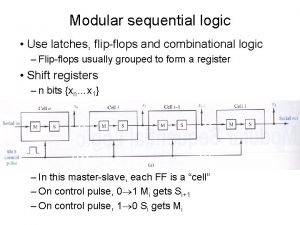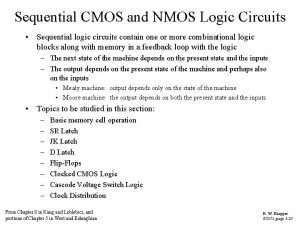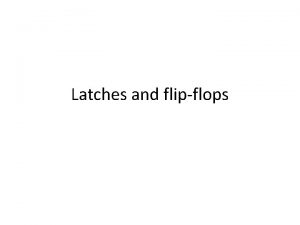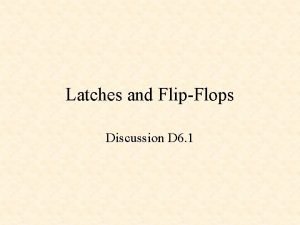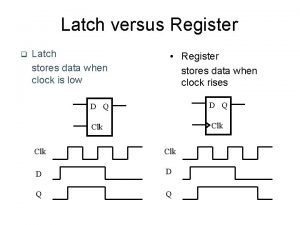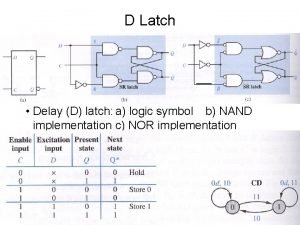Delays in Latches A latch is a pair









- Slides: 9

Delays in Latches • A latch is a pair of cross-coupled inverters – They can be NAND or NOR gates as shown – Consider their behavior (each step is one gate delay in time) – From R and S to P and Q stable condition is reached in three gate delays R S R Q Q P S P 1

Delays in Gated-Latch and Flip-Flops • G acts as a control signal in a gated latch – G = 0 means no writing, G = 1 allows writing • In an edge-triggered flip-flop, data is written in flip-flop upon arrival of a clock edge • This is achieved by connecting two gated latches as shown • Actual implementation may be slightly different, concept is same R D G S D Q P G P R D D G C Q S D D Q G P C R Q P D G S Q P 2

Timing Issues in D Flip-flops • When C is low, second gated latch does not record anything, but the first latch samples the D-input • Before the clock changes from low to high – Changes in D propagate through many gates to output. Therefore D should be stable for at least five gate delays – This represents the set up time of a flip flop • When clock changes from low to high – The first latch may still sample up to two gate delay time. Therefore, D should remain stable even after clock changes – This is called the hold time of a flip flop R D D G C S R Q P D G S Q P 3

Timing in a State machine • The blocks of a Moore machine are shown below • Next state logic determines the next state based on current state and next input • Output logic determines the output based on current state • From rising edge, stored state is stable after four gate delays • Next state logic may take 2 or more gate delay worth of time – This is called contamination time, the minimum time taken for output to change after input changes • And then input to latches must remain stable for set up time I N P U T S Next State Logic Output Logic O U T P U T S 4

Example S 0 S 1 S 2 • Consider a four states system • State transition table, implementation level state transition table, output table, and implementation level output tables are S 3 • Using the logic equations below, combination logic takes two gate delay L 2 = XY’+XY = X X : = X’Y+XY’ L 1 = X’Y+XY = Y Y : = X’Y’+XY’ = Y’ L 0 = X’Y’+X’Y+XY’+XY = X’+X = 1 5

Recap All Delays • A combination circuit has – Contamination delay (tcd) -- Minimum delay before output starts to change 2 to 3 gate delays (depends on # of levels) – Propagation delay (tpd) -- Maximum delay after which all outputs are stable once input change • A flip-flop has set up time -- about 5 gate delay • A flip-flop has hold time -- minimum time for which input to latch should not change after a clock edge -- about 2 gate delay • A flip-flops propagation delay is time from clock edge to time at FF Propagation Time FF Set up Time which its output is stable. • Clock low time > set up time • Clock high time > FF Prop • Clock time > FF Prop + compute + set up time FF Hold Time Compute Time 6

Clock Cycles • Computing contamination delay (tcd) and propagation delay (tpd) of a combinational circuit – It depends on various paths in the circuit – We need to find the shortest path for contamination and longest path for propagation • For the circuit given below – Contamination delay = …. – Propagation delay = …. . • Clock cycle time must allow for propagation delay of circuit, set up time of FF, and propagation time of FF • Contamination time of combinational circuit must be lower than hold time of FF Tcd = 2 Tpd = 5 cd T = 5 Tcd = 2 T =5 Tpd = 8 Tpd = 10 Tcd = 2 Tpd = 5 7

Speed of the circuit and clock frequency • • Clock cycles are determined based on timing considerations Circuit runs at clock speed of f Corresponding clock cycle time (period) is T = 1/f Or f = 1/T A frequency of 1 MHz gives a clock cycle time of 1 micro second A frequency of 500 MHz gives a clock period of 2 nano second Let – T be the clock period – tpd be the propagation time of combinational circuit – tcd be the contamination time of combinational circuit – trd be the propagation time of FF (register) circuit – tst be the set up time of FF (register) circuit – tht be the hold time of FF (register) circuit 8

Some Relationships in state machine times • What is the minimum clock period? – T = tpd + trd + tst • By how long must any change in external inputs precede the next clock edge? – tpd + tst • How long after the clock edge must the external inputs be held valid? – tht - tcd • what is the smallest time after the clock edge that external outputs can be expected to be valid? – trd + tpd 9


